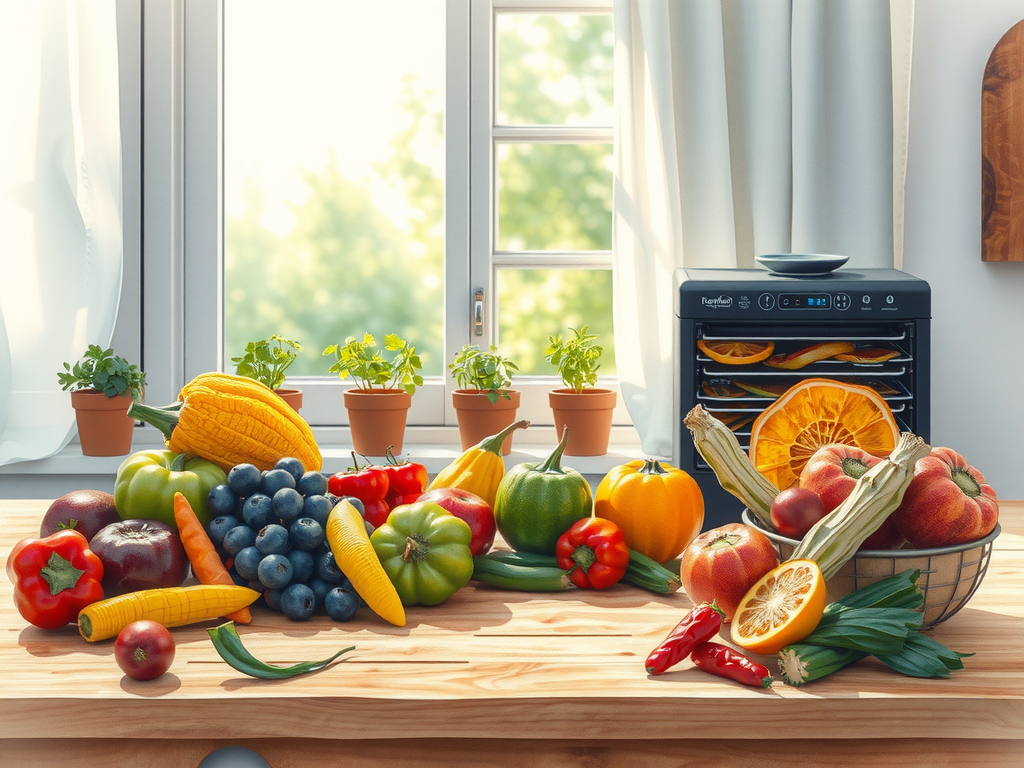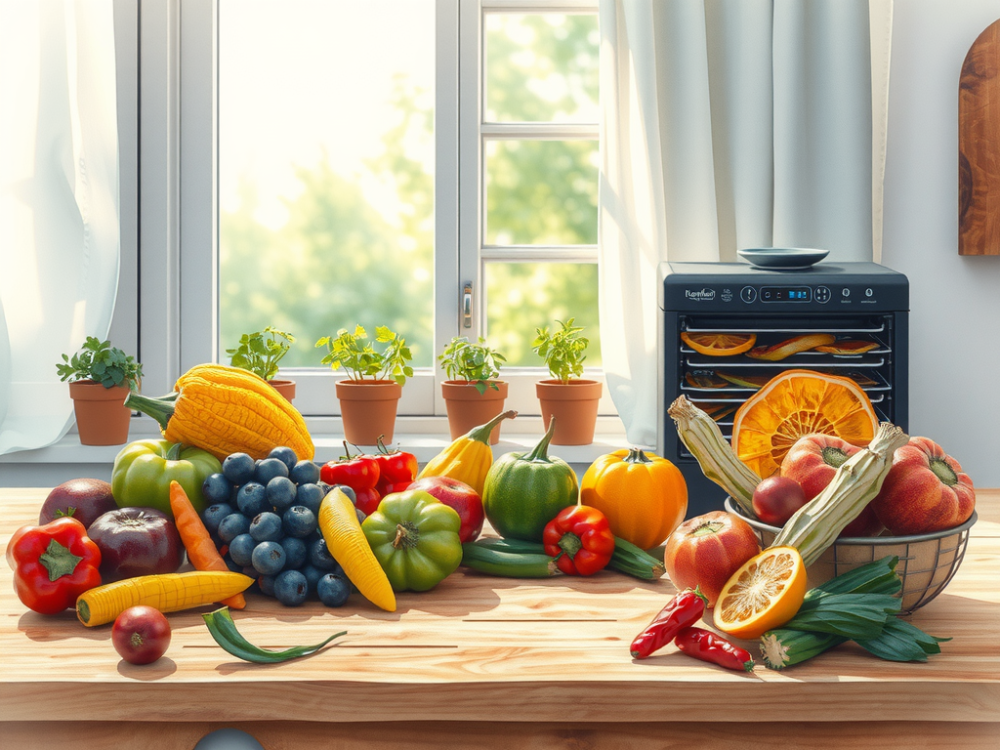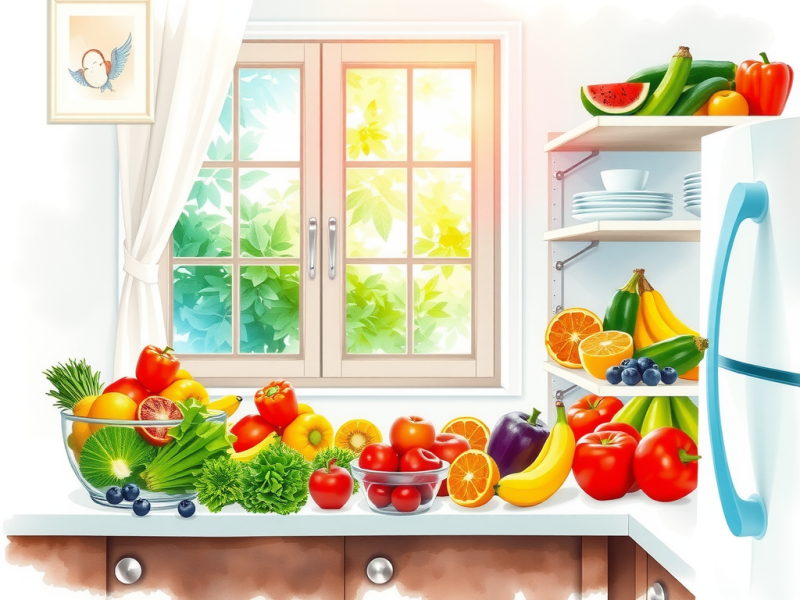
Food dehydrators are great appliances for food preservation. They help create healthy snacks like dried fruits, vegetable chips, and homemade jerky.
These energy-efficient drying devices remove moisture, which extends shelf life.
To get the best results, always cut food into uniform slices for even drying.
Avoid overcrowding the trays to ensure proper air circulation. For long-term storage, store your dried foods in airtight containers.
You might also consider vacuum sealing to keep your food fresh. Follow these tips to make the most out of your dehydrator.
Click here to learn more about: freeze dryer vs dehydrator
Understanding The Dehydration Process
The dehydration process focuses on moisture removal from food.
This method prevents spoilage by slowing down bacteria and mold growth.
It also helps with nutrient retention.
When selecting fruits and vegetables for dehydration, choose those with low moisture content to avoid spoilage. For example, soft fruits like peaches and firm vegetables like carrots are excellent choices.
Proper moisture removal is essential for effective drying and maintaining quality.
Tips for Optimizing Dehydration
Use the right temperature for different foods.
Herbs dehydrate at 95°F, while fruits require 135°F. For meats like jerky, heat to 140°F after pre-cooking to 165°F.
Ensure that food pieces are cut to uniform sizes, no thicker than 1/4 inch.
This helps with even drying.
Avoid overcrowding the trays to improve air flow. Blanching vegetables like carrots or potatoes before drying can help preserve their color and texture.
Storing Dehydrated Foods
Store dried foods in airtight containers in cool, dark places.
This maximizes shelf life. Consider vacuum sealing for long-term preservation and flavor retention.
Dehydrated foods are nutrient-dense and can be rehydrated for various recipes.
Benefits of Using a Food Dehydrator
Food dehydrators save space by compacting food, reducing bulky items into lightweight snacks.
This also helps with food waste reduction by preserving seasonal or excess produce.
Use your dehydrator for unique recipes like granola, herbal teas, or dog treats. These appliances are suitable for both personal and commercial use.

How To Preserve Nutrients Effectively
Preserving nutrients during dehydration is essential for maintaining food quality. Optimal methods can significantly enhance nutrient retention.
For dehydration, using lower temperatures is important; aim for 135°F for fruits to minimize nutrient loss.
Foods dehydrated under proper conditions can retain up to 97% of their nutrients.
Monitor drying time closely to achieve the best results. Checking for dryness at regular intervals avoids over-drying.
Balancing timing and temperature settings protects the vitamins and minerals in your food while creating nutrient-dense snacks. These techniques can lead to successful home drying that supports healthy eating.
Creative Uses For Dried Fruits
Dried fruits enhance meals with flavor and nutrition.
Consider these simple recipes:
- Breakfast: Add dried fruits to oatmeal or yogurt for an energy boost.
- Salads: Toss dried fruits into salads for added sweetness and texture.
- Trail Mix: Create a mix with dried fruits, nuts, and seeds for a healthy snack.
- Smoothies: Blend dried fruits with yogurt and spinach for a tasty drink.
To maintain quality, store dried fruits in airtight containers. Keeping them in a cool, dark place helps preserve their flavors and nutrients, making them ideal for cooking with dehydrated food.
Nutrient Preservation and Dried Fruits
- Dehydrating fruits at 135°F can help retain up to 97% of their nutrients.
- Regularly checking for dryness during dehydration prevents over-drying and preserves quality.
- Storing dried fruits in airtight containers in a cool, dark place extends their shelf life and maintains flavor.
- Dried fruits can be easily incorporated into various meals, enhancing both taste and nutritional value.
Tips For Making Vegetable Chips
Creating delicious vegetable chips at home is healthy and satisfying. Choose fresh vegetables such as kale, carrots, or zucchini for the best taste.
Uniform slicing helps; aim for slices no thicker than 1/4 inch for even dehydration.
Season your chips with herbs, spices, or nutritional yeast instead of salt for natural flavor enhancement.
Moisture removal is vital; dehydrate at 135°F for optimal crunch. Store your finished chips in airtight containers to preserve texture and freshness.
This DIY preservation method reduces food waste and creates nutrient-dense, lightweight snacks for everyone.
Exploring Healthy Snacks With Dehydrators
Food dehydrators provide a simple way to create nutritious snacks at home. These compact appliances can dry fruits, herbs, and even meats.
Create healthy snacks like dried fruits, vegetable chips, and beef jerky.
Rehydrate dried ingredients for soups, casseroles, or smoothies.
Dehydration also reduces food waste by preserving seasonal produce.
Experimenting With Flavors
Experimenting with herbs and spices is easy; mix oils or vinegars with spices for unique profiles. Dehydrating certain herbs can enhance soups or salads, making them versatile for everyday cooking.
Maximizing Your Dehydrator
To get the most out of your dehydrator, follow these simple tips:
- Cut food to uniform sizes for even drying.
- Use correct temperatures for different foods (herbs at 95°F, fruits at 135°F, meats at 140°F).
- Avoid overcrowding trays; ensure good airflow around each piece.
- Blanching vegetables like carrots before dehydrating can preserve color and texture.
- Store dried foods in airtight containers to maximize shelf life.
- Consider vacuum sealing dehydrated foods for long-term preservation.
With proper air circulation and moisture removal, dehydrators help create healthy, portable snacks that fit any lifestyle.
Dehydrating Foods
- Dehydrating fruits and vegetables can retain up to 97% of their nutrients compared to traditional cooking methods.
- Homemade vegetable chips can have significantly less sodium than store-bought varieties, promoting heart health.
- Using a food dehydrator can extend the shelf life of seasonal produce by months, reducing food waste.
- Dehydrated snacks are lightweight and portable, making them ideal for on-the-go nutrition.
The Benefits Of DIY Preservation
Homemade preservation proves to be a smart choice for both your wallet and the planet. DIY preservation significantly reduces food waste, making it an environmentally friendly option.
This method allows you to control ingredients, ensuring your snacks are free from harmful additives.
Making snacks at home can help you avoid preservatives found in store-bought options.
Start small by using seasonal produce, as they are fresher and often more affordable. Preserving seasonal produce maximizes flavor while supporting local farmers.
- DIY preservation is cost-effective and reduces waste.
- It gives you complete control over snack ingredients.
Techniques For Flavor Enhancement In Snacks
Flavor enhancement can elevate your homemade snacks significantly. Seasoning and ingredient pairing are essential for better taste. By marinating ingredients before dehydration, you enrich flavors and add complexity. Using herbs and spices enables you to customize snacks to your preference. A practical tip is to balance sweet and savory profiles for maximum enjoyment. For example, pair dehydrated fruits with nuts for a satisfying snack experience.
Marinating for Better Flavor
Marinating ingredients improves the flavor of dehydrated snacks, creating a deeper taste experience.
Balancing Flavors
Balancing flavors leads to more enjoyable snacks. Mixing sweet and savory options provides a unique taste profile.
- Marinating improves the flavor of dehydrated snacks.
- Balancing flavors creates more enjoyable taste experiences.
Food Dehydrators: Uses and Tips for Optimization
A food dehydrator is a useful appliance designed to remove moisture from foods. This process preserves and extends shelf life while maintaining nutritional value. Dehydrators circulate warm air at low temperatures, offering an energy-efficient alternative to freezing or canning.
Uses of a Food Dehydrator
- Preserve fruits, vegetables, herbs, and meats for extended periods without preservatives.
- Create healthy snacks such as dried fruits, fruit leather, vegetable chips, and beef jerky.
- Rehydrate ingredients for soups, casseroles, and smoothies.
- Save space by reducing the size of dried goods.
- Reduce food waste by preserving seasonal or excess produce.
- Experiment with recipes like granola or dog treats.
Tips for Using a Food Dehydrator
- Cut food to uniform sizes for even drying (e. g. slices no thicker than 1/4 inch).
- Use correct temperatures for different foods (e. g. herbs at 95°F, fruits at 135°F, meats at 140°F).
- Avoid overcrowding trays; ensure good airflow around each piece.
- Blanch certain vegetables before dehydrating to preserve color and texture.
- Store dried foods in airtight containers in cool, dark places.
- Vacuum seal dehydrated foods for long-term preservation and flavor retention.
| Benefits of DIY Preservation | Food Dehydrator Uses |
|---|---|
| Reduces food waste | Preserve fruits, vegetables, herbs, and meats |
| Control over snack ingredients | Create healthy snacks like dried fruits and jerky |
| Cost-effective | Rehydrate ingredients for various dishes |
| Supports local farmers | Experiment with recipes like granola or dog treats |
Best Practices For LongTerm Storage
Effective food preservation helps maintain quality and safety. Proper storage extends shelf life and reduces food waste.
Packaging is important.
Use airtight containers to keep food fresh.
Temperature control is necessary; keep food in a cool, stable environment.
Labeling containers with the storage date helps track freshness easily.
Use the FIFO method—First In, First Out—to use older items first.
This method ensures food remains at its best quality.
Environmental Factors in Preservation
Environmental factors greatly affect long-term storage.
Moisture and light can spoil food.
Keep food in dark, dry places for optimal freshness.
Air circulation plays a role too. Good air circulation helps prevent spoilage.
Maintain a consistent temperature to ensure food safety.
Practical Tips for Optimal Freshness
Follow these tips for long-term food storage:
- Use airtight containers to minimize air exposure.
- Store food in cool, dark places.
- Label and date containers for easy tracking.
- Use the FIFO method to prioritize older food.
These practices help preserve nutrients and maintain food quality. A focus on proper packaging and environmental control extends shelf life.
Food Dehydrators: Uses and Tips for Optimization
A food dehydrator removes moisture from foods. This process preserves food and extends shelf life while keeping nutrients intact. Dehydrators circulate warm air at low temperatures, making them an energy-efficient method compared to freezers or canning.
Uses of a Food Dehydrator
Food dehydrators have many uses:
- Preserve fruits, vegetables, herbs, and meats without preservatives.
- Create healthy snacks like dried fruits, fruit leather, and beef jerky.
- Rehydrate ingredients for soups and smoothies.
- Reduce the size of dried goods for easier storage.
- Minimize food waste by preserving excess produce.
Tips for Using a Food Dehydrator
Here are tips to optimize your food dehydrator:
- Cut food into uniform sizes for even drying—no thicker than 1/4 inch.
- Use correct temperatures based on the food type: herbs at 95°F, fruits at 135°F, and meats at 140°F after pre-cooking to 165°F.
- Avoid overcrowding trays to ensure good airflow.
- Blanch certain vegetables to preserve color and texture before dehydrating.
- Store dried foods in airtight containers in cool, dark places.
- Vacuum seal dehydrated foods for long-term flavor retention.
Food dehydrators are affordable and versatile tools. They help reduce waste and create healthy, nutrient-dense snacks.
| Storage Method | Benefits |
|---|---|
| Airtight Containers | Minimize air exposure and maintain freshness |
| FIFO Method | Ensures older items are used first, maintaining quality |
| Food Dehydrators | Preserve food without preservatives and reduce waste |
| Proper Temperature Control | Prevents spoilage and ensures food safety |



